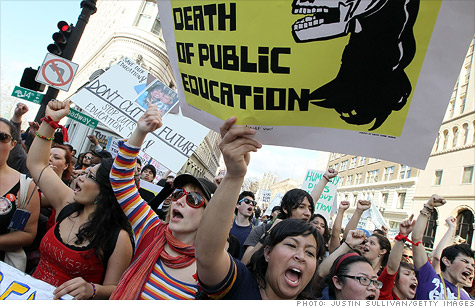 WASHINGTON (CNNMoney) -- Some students will start owing more on their loans while they're in school under a last-minute debt ceiling deal to keep the country out of default and reduce deficits by at least $2.1 trillion over a decade.
WASHINGTON (CNNMoney) -- Some students will start owing more on their loans while they're in school under a last-minute debt ceiling deal to keep the country out of default and reduce deficits by at least $2.1 trillion over a decade.As part of the savings to trim the deficits, Congress would scrap a special kind of federal loan for graduate students. So-called subsidized student loans don't charge students any interest on the principal of student loans until six months after students graduated.
Congress would also nix a special credit for all students who make 12 months of on-time loan payments.
The changes would take place July 1, 2012.
For taxpayers, the savings taken from the pockets of students will total $21.6 billion over the next ten years, according to the Congressional Budget Office.
For graduate students who qualify for the maximum amount of subsidized loans, it could tack several thousand dollars to the cost of going to school.
The idea for the cuts originally came from the Republican-controlled House, but even Senate Majority Leader Harry Reid proposed cutting the graduate school subsidized loans in budget talks last week.
The money saved by the student loan cuts would help pay to keep Pell Grants, which so far are maintained at a maximum grant of $5,500 a year for some 8 million poor students.
Of the $22 billion saved, $17 billion will go to fund Pell Grants, which only leaves that program $1.3 billion short, said student aid groups. That's why most groups can live with the cuts to graduate student loans.
The rest of the savings goes to deficit reduction.
"Full funding for Pell Grants is absolutely essential to fulfilling the president's goal of the U.S. once again having the highest proportion of college graduates in the world by 2020," said Pauline Abernathy, vice president of the Institute for College Access & Success.
The maximum a graduate student can borrow from the federal government is $20,500 a year, including $8,500 from subsidized loans where the federal government absorbs the interest rate while the student is in school. Over the course of a degree, graduate students can accrue up to $138,500 in direct federal loans, with $65,500 from subsidized loans.
A graduate student who borrows the maximum of $65,500 in subsidized loans would owe $207 a month in interest payments over the course of 10 years. But with a subsidized loan, the government pays that $207 each month the student attends school until six months after graduation.
This change would shift some $125 billion in loan volume over to unsubsidized loans and would cost students $18.1 billion over the next decade, according to the Congressional Budget Office.
Graduate students would start accruing the interest rate payments while they're in school, but they wouldn't have to start making payments on the interest or the principal until after graduation. They can choose to pay the interest while they're in school.
"With the elimination of the graduate interest subsidy, it is also clear that graduate and professional school students will be hard-hit in terms of their total indebtedness," said Justin Draeger, president of the National Association of Student Financial Aid Administrators. "Our members are disappointed to see the pullback in loan repayment incentives."
The other big cut that Congress is targeting is a credit that all students get on the origination fee they pay the federal government to process their loans. Students pay 1% of a Stafford loan as an origination fee, but all students get half of that back unless they miss one of their first 12 payments.
The loss of that credit would cost a student who borrows $5,000 from the federal government $25. This would cost students $3.6 billion over the next decade, according to the budget office.
Origin
Source: CNN Money
No comments:
Post a Comment